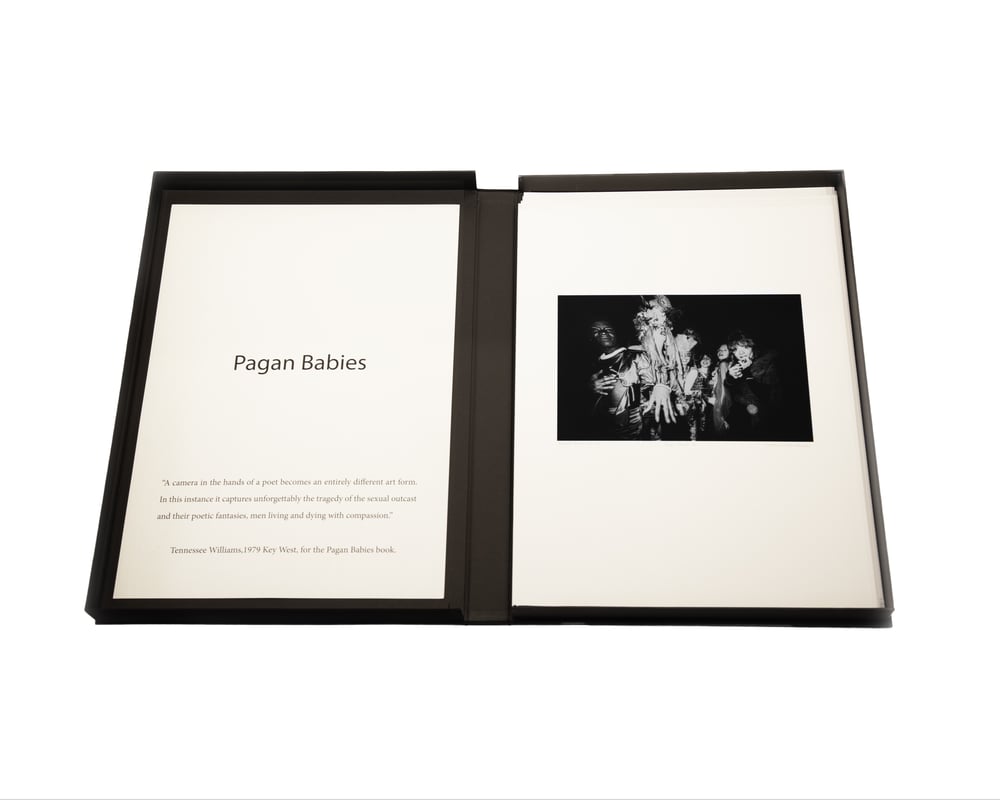Pagan Babies Print Portfolio
$2,500.00
Portfolio comprised of thirteen artist proof prints from original photographs taken by John Denny Ashley from the Pagan Babies series on view at Institute 193 (September 14 - November 4. 2023).
Institute 193 is pleased to announce Pagan Babies, presented in tandem with a publication by the Faulkner Morgan Archive and Institute 193 of the same name and distributed by the University of Kentucky Press. The exhibition is largely comprised of a thought-to-be-lost portfolio of photographs produced by John Denny Ashley in collaboration with the artist Robert Morgan and his cadre of artists and misfits from the mid-1970s into the 80s. In addition to Ashley’s photographs, the exhibition contains work by other artists depicting the Pagan Babies and their predecessors.
"In Ashley’s images, the Pagan Babies, with Morgan almost always as the principal subject, inhabit myths from the ancient world, becoming gods, goddesses, and monsters. Settings range from the controlled environment of a photo studio to a bustling Lexington gay bar, to a serene location along the nearby Elkhorn Creek, and into the slowly dilapidating mansions of the city’s formerly genteel downtown. The effect of the exquisitely, magically costumed subjects performing in these disjointed and anachronistic settings is disorienting, strange, and brilliant. Artemis sits on a satin-sheened chair in full regalia, a deeply cracked oil portrait of a wealthy young woman hanging above her. Morgan’s drag alter ego Peggy Fury reclines on a couch flanked on three sides by a miniature reproduction of Michelangelo’s Pieta, Marlene Dietrich, and Jesus Christ. Flower-haired nymphs look back at their voyeur from the rushing, light-dappled water. The subjects, always glamorous, are in various forms of drag and costume. Bird wings, butterflies, wasp nests, and feathers come together to form a headpiece, another features artificial fruit and what might be crepe paper hair. Ashley’s camera renders the humble materials as sumptuous and fine.
The photographs are proof of a thriving community of unabashed sexual and gender outlaws in the historical record of a time and place which frequently erases or minimizes the existence of such people. Against considerable odds, Morgan and his compatriots flouted conventions of gender display and sexual openness, both in front of Ashley’s camera, and in their lived experience, an openness that would expose them to the possibility of violence, state-sanctioned or otherwise.
Although many of the photos were thought to be lost until recently, the spirit of the Pagan Babies as a social and artistic informal collective would remain and proliferate through the following decades in Lexington, with Morgan always at the center, encouraging and supporting new generations of young queer artists and advocating on behalf other marginalized groups in various capacities, especially those impacted by the HIV/AIDS epidemic and substance use disorders.
Now, a half-century after their inception, Ashley’s photographs have taken a circuitous and sometimes troubled path to publication and exhibition. Around the time they were produced, they were lauded by Tennessee Williams in a statement from which only one sentence remains. A deal with the book publishing arm of Aperture was abandoned after Ashley refused it, and the relationship between Morgan and Ashley soured as a result. Many of the photographs were never printed from the negatives, and the prints that did exist wound up under beds and tucked in attics.
Morgan would, as his mentor and queer forebearer Henry Faulkner suggested, ‘Save the seeds, children.’ Collected over the course of decades and compiled from over a century of Lexington and Kentucky’s queer history, the seeds that Morgan saved would in 2014 form the basis of the collection that is now the Faulkner Morgan Archive, which has quickly become one of the largest LGBTQ+ archives in the American South. It is through the network that Morgan helped to build over those years that these images have been finally brought to life for the newest generation of Pagan Babies to see."
–Paul Michael Brown
Printed by John Hockensmith
Dimensions: 23 x 16.5 inches


